De-worming
About worms in horses
Horses and ponies can have a variety of intestinal worms from time to time, so when caring for them it is essential to have an effective parasite control program in place.
If allowed to become a heavy infestation, worms and other internal parasites can pose a significant threat to the health of horses. There are many different types of worms and parasites which can cause extensive internal damage without you knowing. The most common types of worms that affect horses are strongyles (large and small), large roundworms (ascarids), pin worms, bots and tapeworms.
Decades of frequent de-wormer medication has resulted in high levels of drug resistance in small strongyles and ascarid populations. Drug resistance means the parasites within an animal have the capability of surviving treatment with a particular class or family of de-wormer.
Developing a de-worming program is an essential part of good horse management and will vary according to the age and movement of horses on and off the property. We recommend working together with our vets at Illawarra Equine Centre to develop a program specific to your horse's needs. Creating an effective parasite control program is paramount to you horse's health and well-being and requires a combination of management strategies and de-worming medications.
Symptoms - what to look for
A horse with a heavy worm burden may have symptoms such as trouble putting on weight, a dull appearance to its coat and possibly a reduced appetite, mild colic symptoms or anxiety. Worms such as pin worm can cause an irritation often seen when the horse rubs out its tail. If left untreated symptoms can progress to include diarrhoea, anaemia, lowered ability to exercise (e.g. lethargy), susceptibility to infections, non-healing sores (“summer sores”), coughing and significant or recurrent colic. If still untreated parasites can cause pneumonia, emaciation, severe and debilitating diarrhoea, permanent organ damage and colic, it is possible that some of these could lead to death. Given all these symmtoms, worm infestations and other internal parasites can pose a significant threat to the health of horses.
Varieties of worms
Strongyles
Adult large strongyles (sometimes called bloodworms) are found in the large intestines either attached to the walls or in the intestinal contents. There the females deposit large numbers of eggs that are excreted in the manure. These eggs then hatch and the larvae develop and climb blades of grass. Horses then consume these larvae while grazing and ingested larvae penetrate the intestinal walls and migrate to various organs and arteries. Large strongyles mature about 6 to 11 months after larvae are ingested. Small strongyles larvae migrate into the intestinal wall but not into other organs or blood vessels. Small strongyles develop to maturity about 6 to 10 weeks after larvae is consumed. All horses can be affected by strongyles but young horses are most vulnerable. Signs of strongyle infection are loss of appetite, weight loss, fever, depression, weakness, anaemia, diarrhoea and death.
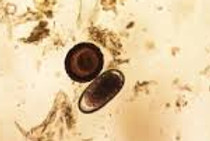
Large Roundworms
The adult stage of the large roundworm (ascarid) is found in the small intestine of the horse. The female lays large numbers of eggs in the intestines which are passed out in the manure. It takes approximately 2 weeks for these eggs to be infective and the horse picks them up while grazing. The eggs hatch in the stomach and intestines and migrate into the blood circulation where they are carried to the liver and lungs. A complete life cycle takes 3 months and eggs can remain infective in the environment for several years if not properly removed. Large roundworms cause digestive upset and damage the liver and lungs, if the burden is large enough, rupture can occur in the small intestine leading to death.
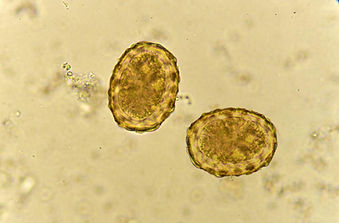
Pinworms
Pinworms mature in the large intestine and rectum of the horse. The eggs of pinworms are picked up by horses from contaminated feed, water, bedding, stall walls, fences etc. These worms are irritating and cause the horse to rub its tail, resulting in hair loss. The eggs are smeared onto any surface the horse touches and some are passed in manure. Pinworms can affect all ages but young animals are most susceptible, with symptoms including digestive disturbance, slow growth, irritation and tail rubbing. The life cycle is completed in five months.
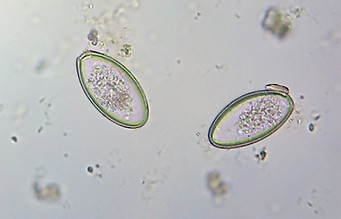
Bots
Bots are the immature stage of the bot fly. The female bot fly lays their yellow eggs on the hairs of the horse, typically on the throat, front legs and underline. The eggs containing first stage larvae hatch after a 2- to 5-day incubation period either freely or after being licked by the horse. The larvae then migrate to or enter the mouth and attach to the lips, tongue, gums or other parts of the mouth and burrow into the tissue. About three weeks later they emerge as second stage larvae and progress down the throat, attaching to the stomach lining. In the stomach they develop to third stage larvae and remain for up to 7 months. Damage in the stomach occurs due to obstruction of food flow and irritation of the stomach lining. In severe case stomach rupture can occur. These larvae finally pass through the horse and hatch from manure by entering the soil below the manure pile and pupate in approximately 2 weeks to 2 months depending on the season (from spring to autumn).
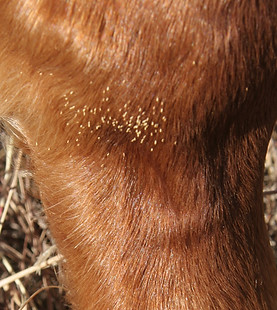
Tapeworms
Tapeworms attach to the horses intestinal lining where they rob the horse of nutrients and damage tissues. Horse tapeworms require a host (forage mite). Tapeworm eggs are passed with the manure of infected horses onto pasture, where forage mites ingest them. The immature tapeworm develops within the body cavity of the mite and is ingested by the grazing horse. When the horse digests the infested forage mite, the tapeworm is released and within 6-10 weeks develops into an adult that attaches to the horse’s intestine and continues the cycle.
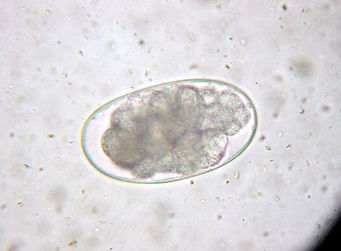
Prevention and control
Pasture management
The control of worms can be greatly assisted by good paddock management.
-
Remove manure from pastures as often as possible. In small pastures (less than 3 acres) manure should be removed from the paddock at least twice a week and placed in a compost pile. The larvae in composted manure will be destroyed if sufficient heat is built up. In large pastures frequent mowing, harrowing, and rotation of pastures will be effective.
-
Harrowing and mowing helps manure to dry out which helps to kill the worm larvae particularly if done in the morning on hot days. Vacuuming or collecting manure in pasture is time consuming, but can be very effective.
-
Grouping horses in pastures according to age will help minimize young horses coming in contact with heavy larval infestations. For example, pasture mares and foals away from other horses less than 2 years of age. Yearling horses often need a different control program than a broodmare. It can be more difficult to control parasites in a herd if all ages and classes of horses are in a pasture together.
-
After de-worming, pasture should be rested for a minimum of 6 to 8 weeks. Where possible add sheep or cattle to your rotation to cut down on parasite numbers. Alternative grazing with ruminants and pasture rotation schemes will aid in disrupting the parasite life cycle. Grazing ruminants in rotation with horses will reduce parasite infestation, because most internal parasites are host specific. Pasture rotation may also help by decreasing incidence of overgrazing, thus decreasing ingestion of parasites.
-
Feed horses from buckets or tubs and put hay in racks of hay feeder to avoid contamination with manure.
-
New horses to a property should be kept separate from existing horses until their parasite burden is assessed.
Egg removal
In the case of bot fly eggs, which can be seen on the legs, neck and belly of the horse, these can be carefully removed with a bot knife, which has a rounded blade with a serrated edge. Place the knife above the egg and scrape downward. The eggs will fall to the ground, so be sure to do this far from where your horse grazes.
Pin worms can be spread by the horse onto fences and stable walls. Any surface that may have been contaminated should be scrubbed using a hard-wire brush and a non-toxic disinfectant and feed and water sources should be thoroughly cleaned, to prevent re-infection.
De-Worming treatments
The four main de-worming chemical groups are:
-
Benzimidazoles (white drench)
-
Tetrahydropyrimidines (clear drench)
-
Macrocyclic lactones, and
-
Pyrozine
It is recommended that chemical groups be rotated every 3rd time you de-worm, to delay a build-up of resistance in worms to a particular drench chemical. Praziquantel is the only de-wormer effective at killing tapeworms.
Changing the brand of de-wormer does not mean you are changing the active ingredient, make sure to check the active ingredients.
Which active ingredient should I use and when?
Mature horses
Focus on control of small strongyles. Depending on climatic conditions, one or two yearly treatments are sufficient to prevent occurrence of strongyles. Treatment is best done towards the end of the grazing season when internal parasite burden is at its peak (spring in tropical and subtropical climates). Include treatments against bots (along with removal of bot eggs from the horses’ hair coat), ivermectin & moxidectin are the only available medications for horses with activity against bots. Include a tapeworm treatment (Praziquantel) at least annually if they are a problem in your region.
Foals and weanlings
During the first year of life foals should receive a minimum of four de-worming treatments. Their first treatment should be at 2-3 months of age, with a benzimidazole drug to ensure efficacy against large roundworms. Second de-worming is recommended just before weaning (approximately six months of age). An extra treatment can be justified before weaning if the time period between the two treatments exceeds 3 months. At weaning a fecal egg count is also recommended to determine whether worm burdens are primarily strongyles or large roundworms, to facilitate the right choice of drug class. Third and fourth treatments should be considered at about 9 and 12 months of age, respectively, and treatment should primarily be targeting strongyles. Tapeworm treatment should be included on one of these latter treatment occasions. Recently weaned foals should be turned out onto the “cleanest” pastures with the lowest parasite burdens.
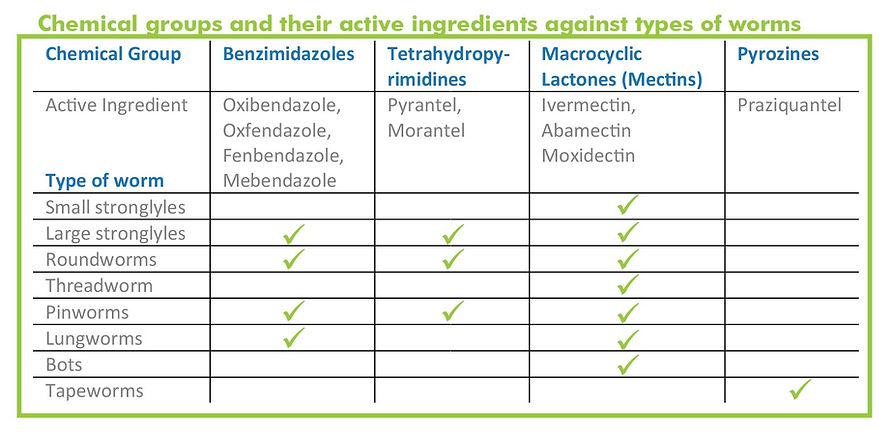
Faecal Egg Count
Treatment for worms with de-worming medications should be based on faecal egg count examination. A periodic faecal egg count (FEC) is the most accurate way to determine when to de-worm. An FEC measures the number of strongyle or ascarid eggs your horse is passing in each gram of his manure.
All new horses should have an initial FEC test conducted and then biannual to annual tests (in the spring and autumn) should be conducted in mature horses depending on their exposure to other horses. Horses under the age of 2 may need more frequent FEC test conducted (every 6 months). The cost of an FEC is currently only $35.00 per sample.
Initial FEC will determine worm burden and a follow-up FEC 14 days after de-worming will evaluate medication effectiveness (Table 2). If used correctly, a FEC can decrease your reliance on de-worming medications reducing the risk for drug resistance.
Using our in-house testing equipment at Illawarra Equine Centre office, we are able to assess the samples and report back to you within 24 hours with the number of EPG (eggs per gram).
Contamination levels
Low - Less than 200
Moderate - 200 to 500
High - More than 500

How to collect a manure sample for testing:
-
Prepare a cold bag with ice packs.
-
Take a zip lock plastic bag, and write the horse's name and the date on the outside with a permanent marker.
-
Wait for horse to pass manure. Alternatively, manure piles less than 12 hours old can be used if you know which horse the pile came from.
-
Once manure is passed:
-
Turn the bag inside-out.
-
Put your hand in the bag and use it to collect manure from multiple locations in the pile (do not take pieces that are touching the ground). Take the equivalent of at least 2 manure balls (it is better to take too much sample than too little).
-
Invert the bag so that manure is on the inside.
-
Remove as much of the air as possible before sealing the bag.
-
-
Place bag in designated cooler with ice packs or a barn refrigerator if available. Keep manure cold until you are able to give it to Illawarra Equine Centre.
